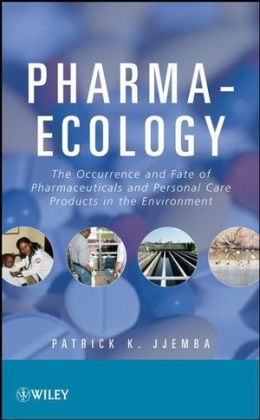
Pharma–Ecology
Wiley-Blackwell (Verlag)
978-0-470-04630-2 (ISBN)
- Titel ist leider vergriffen;
keine Neuauflage - Artikel merken
Pharmaceuticals and personal care products--we can't live without them. Can the environment survive with them? Pharmaceutical and personal care products (PPCPs) are increasingly being recognized as micropollutants. In this context, pharmaceutical products encompass a diverse range of drugs used to treat various illnesses, and personal care products include everyday items such as soaps, fragrances, cleaning agents, disinfectants, and similar products. Written for professionals from different backgrounds, Pharma-Ecology bridges the knowledge and language gap and critically examines the issue of PPCP micropollutants and how to best minimize their impact on the environment.
Organized systematically, it:* Presents a range of pharmaceutical compounds categorized by mode of action and common usage, displaying the volumes (or number of prescriptions) that are dispersed* Discusses the detection of PPCPs in the environment using instrumentation and bioassay techniques, including microarrays* Covers the occurrences of PPCPs in aquatic systems, sediments, soil, and aerial environments* Considers the persistence and degradation of PPCPs in the environment, and links pharmacokinetics/pharmacodynamics with the kinetics of PPCPs in the environment* Explores engineering and treatment techniques that could minimize the impact of PPCPs in the environment* Includes numerous tables and figures that illustrate informationThis is an enlightening reference for engineers, toxicologists, ecologists, micro-biologists, and chemists involved in pollution and environmental analysis; policy-makers; professionals in federal and state regulatory agencies; and pharmaceutical professionals. It is also an excellent text for undergraduate and graduate students in related fields.
Patrick K. Jjemba, PhD, is a Senior Research Analyst for Innovation and Technology with American Water. Previously, he was a research associate in the Department of Civil and Environmental Engineering at the University of Cincinnati. Dr. Jjemba has received grants from the NIEHS, World Bank, and IAEA and has authored several peer-reviewed papers, including two reviews covering pharmaceuticals as environmental pollutants.
Preface. Chapter 1 Usage of Pharmaceutical and Personal Care Products for Different Therapeutic End Points in Relation to Environment. 1.1 Personal Care Products. 1.1.1 Fragrances and Musks. 1.1.2 Detergents. 1.1.3 Disinfectants. 1.2 Pharmaceutical Compounds. 1.2.1 Antihypertensive and Cardiovascular Medications. 1.2.2 Anxiolytic Sedatives, Hypnotics, and Antipsychotics. 1.2.3 Analgesics and Anti-inflammatory Drugs. 1.2.4 Antimicrobial Compounds. 1.2.5 Gastrointestinal Drugs. 1.2.6 Antidiabetic Drugs. 1.2.7 Diuretics and Electrolytes. 1.2.8 Thyroid System Medication. 1.2.9 Respiratory Drugs. 1.2.10 Oral Contraceptive and Reproductive Therapeutics. 1.2.11 Biophosphonates and Other Skeletal Ailment Drugs. 1.2.12 Steroids. 1.2.13 Hematologic Drugs. 1.2.14 Nutritional Drugs. 1.2.15 Triptans. 1.2.16 Anesthetics. 1.2.17 Antineoplast and Immunosuppressants. 1.3 Conclusion. Chapter 2 Detection and Occurrence of PPCPs in the Environment. 2.1 Detection of PPCPs in the Environment. 2.1.1 Detection Using Instrumentation. 2.1.2 Detection Using Bioassays. 2.2 Occurrence of PPCPs in Various Environments. 2.2.1 Aquatic Systems. 2.2.2 Occurrence of PPCPs in Sediments. 2.2.3 Occurrence of PPCPs in Soil. 2.2.4 Aerial Environments. 2.3 Excretion as a Driver of Pharmaceutical Occurrence in the Environment. Chapter 3 Ecopharmacokinetics and Ecopharmacodynamics. 3.1 Overview of Pharmacokinetics and Pharmacodynamics. 3.1.1 Sorption and Bioavailability of PPCPs in the Environment. 3.1.2 Compound Half-life and Clearance. 3.2 Degradation of PPCPs in the Environment. 3.2.1 Degradation of Antibiotics in the Environment. 3.2.2 Degradation of Analgesics and Anti-inflammatory Drugs. 3.2.3 Degradation of Estrogens and Other Reproductive Hormones in the Environment. 3.2.4 Degradation of Other Important Pharmaceuticals. 3.2.5 Degradation of Surfactants. 3.3 Role of Physicochemical Factors in the Fate of PPCPs in the Environment. 3.3.1 Molecular Size as an Attribute to Absorption and Persistence. 3.3.2 Solubility and Hydrolysis. 3.3.3 Effects of Chemical Dissociation, Partitioning, and Lipophilicity on PPCP Degradability. 3.3.4 Effects of Moisture and Oxygen in the Fate of PPCPs in the Environment. 3.3.5 Effects of Temperature in PPCP Dynamics and Degradation in the Environment. 3.3.6 Other Factors That Determine PPCP Fate and Persistence in the Environment. 3.4 Conclusion. Chapter 4 Ecotoxicity of PPCPs. 4.1 Conventional Assessment of the Risk. 4.2 Ecological Impact of PPCPs on Microorganisms and Microbial Processes. 4.2.1 Antibiotic Resistance. 4.2.2 Biogeochemical Perturbations. 4.3 Effects of PPCPs on Invertebrates. 4.4 Ecotoxicity of PPCPs on Aquatic Organisms. 4.4.1 Endocrine Disrupters in the Aquatic System. 4.4.2 Effects of Antibiotic Resistance to Aquatic Organisms. 4.4.3 Ecotoxicological Effects of Cosmetics on Aquatic Organisms. 4.4.4 Ecotoxicity of Other PPCPs in Aquatic Organisms. 4.5 Ecotoxicity of PPCPs on Terrestrial Wildlife. 4.6 Livestock and Human Health. 4.6.1 Clinical Antibiotic Resistance Cases. 4.6.2 Allergic Reactions Related to PPCPs. 4.6.3 Endocrine Disruption in Humans and Livestock. 4.6.4 Association Between PPCPs in the Environment and Some Cancers. 4.6.5 Other PPCPs of Major Concern to Humans and Livestock in the Environment. 4.7 Ecotoxicity of PPCPs on Vegetation. 4.8 General Considerations in Long-Term PPCP Toxicity. Chapter 5 Technologies for Removing PPCPs. 5.1 Conventional Treatment Systems. 5.1.1 Primary Treatment. 5.1.2 Secondary Treatment. 5.2 Advanced Treatment Processes. 5.2.1 Advanced Filtration Systems. 5.2.2 Oxidation Processes. 5.2.3 Ultraviolet Treatment. 5.2.4 Electrolysis. 5.2.5 Advanced Oxidation Processes. Chapter 6 Future Needs. 6.1 Improving Assessment of the Risks from PPCPs in the Environment. 6.2 Effect of Mixtures. 6.3 Effects of Chronic Exposure to Low PPCP Doses. 6.4 Formulation and Regimen Design Affecting PPCP Bioavailability, Excretion, and Sorption. 6.5 Use of Quantitative Structural Activity Relationships in Ecotoxicology. 6.6 Use of Genomics in Bioassay Studies. 6.7 Social Responsibility, Legislation, and Policy. 6.8 Need to Revisit the Drug Approval and Advertising Process. 6.9 Use of Prescription Records for Mapping PPCPs. References. Index.
| Erscheint lt. Verlag | 12.9.2008 |
|---|---|
| Verlagsort | Hoboken |
| Sprache | englisch |
| Maße | 156 x 243 mm |
| Gewicht | 590 g |
| Einbandart | gebunden |
| Themenwelt | Naturwissenschaften ► Chemie |
| Technik ► Umwelttechnik / Biotechnologie | |
| ISBN-10 | 0-470-04630-9 / 0470046309 |
| ISBN-13 | 978-0-470-04630-2 / 9780470046302 |
| Zustand | Neuware |
| Haben Sie eine Frage zum Produkt? |
aus dem Bereich



